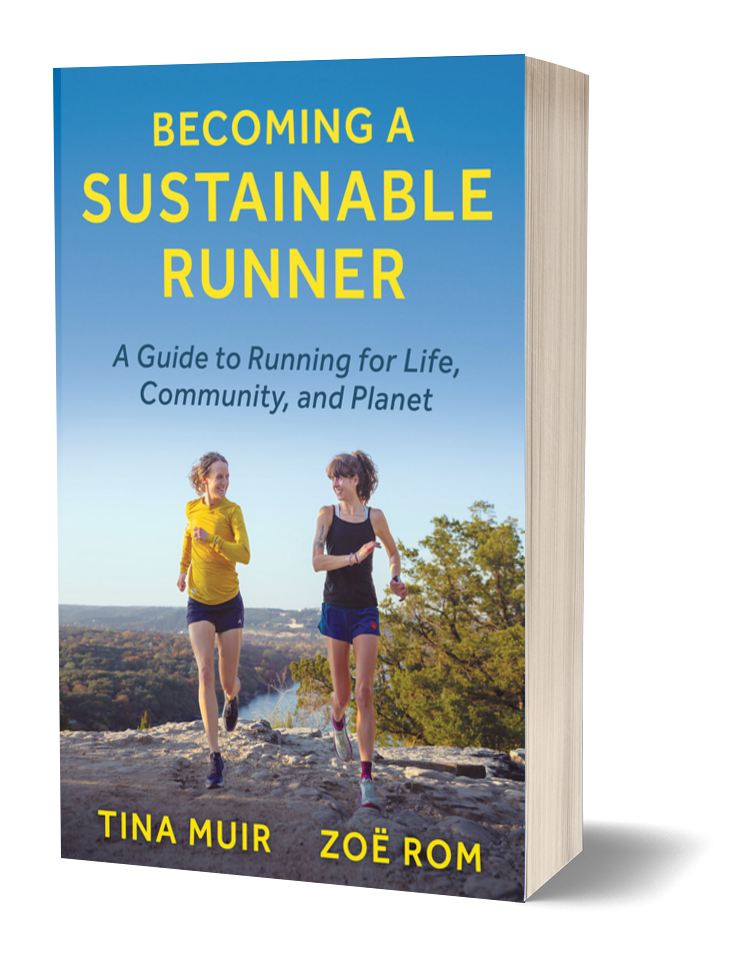The PF&H team are regularly sharing book suggestions in our #BookClub channel on Slack and my latest contribution is Tina Muir and Zoë Rom’s ‘Becoming a Sustainable Runner’.
The pair cover the psychological, physical, social and environmental challenges of being a sustainable runner by sharing personal anecdotes and practical takeaways that make the concept of sustainability seem less overwhelming…
Part 1: Mind and Body
The book kicks off with the parallels between running and life. In all walks of life, hyper-focusing on outcomes and gauging success by comparing yourself to others can take quite the toll on your mental state. Tina and Zoë encourage us to instead turn inward to find our own “why” for running and harness the intrinsic motivation that comes with it.
They note the difference between a “why” and a goal – an underlying purpose vs. a specific objective. It’s easy to let successes be overshadowed by perfectionism, but the more you can embrace the imperfection, the better.
When you think of recovery, you might think of the physical components, but Tina and Zoë highlight the wide range of factors that can support or preclude adequate recovery. The accumulating stress of day-to-day challenges, whether in work, family life or schedules, necessitates having a flexible approach to your running routine.
Technology, overcommitting, and ignoring signs from your body can also get in the way. Tina and Zoë suggest meditation and give practical tips on how to incorporate it into your life… even for those of us who hate sitting still!
Preventing physical injuries is a significant part of staying a runner, and strength training can be a huge help. Balancing total volume is still important as overtraining is a slippery slope. It might start with overreaching, but can quickly spiral into a more serious condition, such as RED-S. I appreciated Tina and Zoë’s acknowledgement of this reality for many athletes, as I’ve even had a bout of it myself.
Tina dives deeper and shares her personal experience of struggling with body image and self-esteem during her own running career. Optimising physicality for your sport can easily turn into an obsession with being as lean as possible and ultimately unwell. In the age of diet culture, Tina promotes a much healthier and sustainable approach to fueling for sport and overall wellness, paired with positive self-talk to appreciate the power of the body.
When you're mentally burned out, Tina and Zoë recommend exploring other variations in training, such as through hill workouts, speed workouts and trail running. Getting creative with your routine can break you out of a slump and rejuvenate your love for running.
Part 2: Community
When it comes to rejuvenating or maintaining your love for running, we’ve written before about the benefits of training with others and it’s a topic that Tina and Zoë touch upon in the ‘Find Your Place’ section of their book.
They highlight the solitary nature of the sport and how it can sometimes feel like an individual pursuit, especially for those who experienced lockdowns during the COVID-19 pandemic. They emphasise that running can be more than just a personal endeavour, and how it can also be a way to connect with a broader community of runners.
Tina draws on her own experiences of becoming too focused on race goals to highlight the fact that running isn’t just about achieving personal records or chasing finish lines. It's also about the connections we build with other runners, the sense of belonging to a larger running community, and the joy of supporting and celebrating each other's successes.
She suggests that participating in group runs can enhance your running experience and provide motivation. It’s something that the PF&H office run club can relate to as knowing that we’ve got other people holding us accountable makes it much more likely that we’ll turn up for that pre-work run in gale force wind and rain on a Thursday morning!
Additionally, Tina and Zoë acknowledge the transformative power of running in bringing about social change and fostering inclusivity within the running community.
Part 3: Planet
The final third or so of Tina and Zoë’s book is reserved for topics that typically come to mind when you hear the word "sustainable", addressing how we can minimise the negative impact we have on the environment and maximise the positive effect we can have through our choices and actions.
Tina and Zoë switch back and forth between breaking down UN climate change reports and sharing personal anecdotes about topics like managing their periods and travelling to races with surprising ease, meaning the section never feels too dense or 'academic'.
Each chapter has an "Action Steps" section at the end with a bullet-pointed summary of steps you can take to become a more environmentally-friendly athlete (and people more generally outside of sport). One tip I'll be employing going forwards is to wash clothes with similar textures together as the friction caused by washing say jeans with soft shirts can cause extra wear and tear, reducing the lifespan of the items.
Another tip is travelling to races with a reusable coffee mug so that you don't have to use takeaway cups. Not revolutionary, just common-sense and something that I'd wager isn't on as many avid coffee-drinker's race packing lists as you'd think.
Tina and Zoë also recommend taking your own fuel and electrolytes to races rather than relying on aid stations. We think this is sensible because you've practised using it in training but, over time, it can also reduce waste as sponsors reduce product allocations based on demand.
Possibly my favourite example of how a seemingly small action can make a difference was the one Tina shared about apparel brand Tracksmith. They came up with a genius way to encourage runners to reuse pins for their race numbers by providing four gold pins with every Van Cortlandt racing singlet sold and a dedicated patch in one corner for the pins to reside between races. Clever.
Overall, this section provides a balanced, informative and actionable guide to becoming a greener athlete. It's supported, but not bogged down, by plenty of data from reputable sources. Whilst it's clear that they are super passionate about helping make sport more environmentally-viable for future generations, Tina and Zoë are realistic and don't come across as 'preachy' (the downfall of many activists). This is definitely worth a read if you're worried about the impact you're having on the planet through your sport...
Whether you’re new to running or have already racked up thousands of miles, Tina and Zoë’s personal insights and creative strategies will help keep you on your feet. There’s more to running than just, well, running. Grab a copy of their book to see for yourself.

